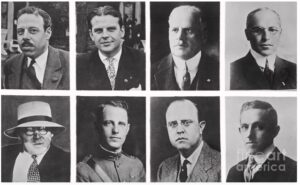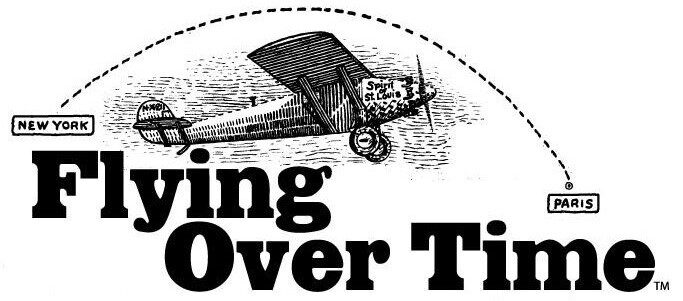
Charles Lindbergh and Donald Hall shaking hands for the camera.
The nine backers of Lindbergh dared to venture into uncharted territory, their collective leap of faith resulting in a momentous turning point in aviation history:
One fine afternoon in the spring of 1927, a relatively unknown airmail pilot by the name of Charles Lindbergh walked into a meeting room in St. Louis, Missouri. Seated around the table were nine of the city’s most prominent businessmen, each more influential than the last.
In that moment, Lindbergh was the embodiment of raw ambition, armed with a daring proposal that had the potential to change the course of aviation history. As he laid out his audacious plan to fly non-stop from New York to Paris, the room was steeped in an air of anticipatory silence. Each word, each diagram, each detail of Lindbergh’s presentation hinted at a future where humans defied the boundaries of the skies.

left to right: Harry Knight, Harold Bixby, and the newspaper publisher of the Globe-Democrat: Lansing Ray with aviation pilot Charles Lindbergh
The nine men listened, their interest piqued. They were Harold M. Bixby, Harry F. Knight, Harry H. Knight, Albert Bond Lambert, J.D. Wooster Lambert, E. Lansing Ray, Frank H. Robertson, William B. Robertson, and Earl C. Thompson. They were pragmatic businessmen, shrewd in their decisions and adept at recognizing potential. Yet they were also visionaries, not averse to taking risks when the stakes were high and the payoff even higher.

Major Albert Lambert
The room pulsed with cautious optimism as Lindbergh concluded his pitch. Each man weighed the risks and rewards. Here was an opportunity to support a venture that could redefine human capability, set a new precedent for exploration, and revolutionize commercial aviation. On the other hand, it was a gamble – a risk that could just as easily lead to disaster.

Charles Lindbergh’s financial backers of the historic flight in the Spirit of St. Louis.
What transpired next was not a mere financial transaction, but a collective leap of faith. Each businessman saw in Lindbergh’s eyes not just an adventurer but a pioneer who, despite the odds, had the audacity to dream. Their decision to back Lindbergh was not solely a business venture but a testament to their belief in the human spirit’s capacity for limitless achievement.

William Robertson
That moment of decision – that point in time when nine men saw potential in the seemingly impossible – marked the beginning of an incredible journey. A journey that would result in the Spirit of St. Louis taking off from Roosevelt Field in New York, and Charles Lindbergh etching his name in the annals of history.
The backers of Lindbergh had the courage to take a chance, a risk that paved the way for a remarkable milestone in aviation history. Flying Over Time aims to cultivate that same spirit of innovation and curiosity. We extend an invitation to you to become part of our mission. With your contribution, you have the opportunity to help turn dreams into reality, much like the nine

The tail of the famous airplane, the Spirit of St. Louis in 1927 at Dutch Flats in San Diego, California. Image taken by engineer Donald A Hall
individuals who backed Lindbergh’s audacious dream.
Biographies of the Nine financial backers:
- Harold M. Bixby: He was a businessman and philanthropist from St. Louis, Missouri, who made his fortune in shipping and transport. As the president of the St. Louis Chamber of Commerce, Bixby was instrumental in raising funds for Lindbergh’s flight. He not only provided financial support, but also played a key role in rallying other local businessmen around the project. After Lindbergh’s successful flight, Bixby became a passionate advocate for aviation and supported several other pioneering flights.

Making History: The three men of the Spirit of St. Louis project (right to left): Donald A Hall, Ben Mahoney, and Charles Lindbergh
- Harry F. Knight: An executive at the Bank of St. Louis, Knight was an influential businessman and one of the primary backers of Lindbergh’s flight. He and his brother, Harry H. Knight, were instrumental in convincing others in the business community to support Lindbergh’s ambitious project.
- Harry H. Knight: Similar to his brother, Harry H. Knight was an executive at the Bank of St. Louis. The Knight brothers were among the first to pledge their support to Lindbergh’s venture, and their endorsement was crucial in persuading other investors to come on board.
- Albert Bond Lambert: Lambert was a significant figure in the world of sports, finance, and aviation. An Olympic golfer, he inherited a fortune from his father, who developed Listerine mouthwash. Lambert was one of the early investors in aviation and had earned a pilot’s license himself. He backed Lindbergh financially and used his influence to attract other investors. Lambert Field, which is now St. Louis Lambert International Airport, was named after him.
- J.D. Wooster Lambert: The son of Albert Bond Lambert, J.D. Wooster Lambert, was an integral part of the backers. However, there is less specific information about his direct involvement compared to others.
- E. Lansing Ray: Ray was a prominent newspaper publisher, having inherited the St. Louis Globe-Democrat from his father. His newspaper provided widespread publicity for Lindbergh’s project, which helped rally public support and attract additional investors. Ray himself was also one of the key financial backers of the Spirit of St. Louis.
- Frank H. Robertson: Robertson was a businessman from St. Louis. While

Vintage photo of eight of the financial backers of Charles Lindbergh and his solo transatlantic flight to Paris in 1927
there is less specific information available about his individual contribution, he was a member of the group of nine businessmen who provided crucial financial backing for Lindbergh’s flight.
- William B. Robertson: Similar to Frank H. Robertson, William B. Robertson was a St. Louis businessman who supported Lindbergh’s venture. However, specific details about his individual contribution to the project are limited.
- Earl C. Thompson: Thompson was a financier and investment broker from St. Louis. He was part of the group of backers who saw potential in Lindbergh’s ambitious project and agreed to provide financial support.
These individuals are often referred to as the “St. Louis Group” or “The Spirit of St. Louis Organization,” and their backing was essential to making Charles Lindbergh’s historic flight possible. Each of them recognized the potential impact of Lindbergh’s proposed flight on commercial aviation and chose to support it despite the considerable risks involved.
